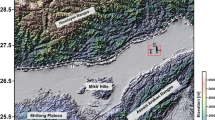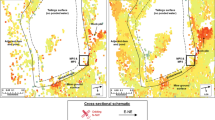Abstract
Measures of grade heterogeneity, or the spatial distribution of grades, depend on the scale of sampling. At the resource modelling scale, heterogeneity measures are limited to the scale of the data used to estimate the model. As denser sampling becomes available (e.g., from blast holes immediately prior to mining), it is, in principle, possible to provide measures of heterogeneity at smaller scales to allow selective mining of large resource blocks. However, this can only be done if the local resource model can be updated rapidly with the newly acquired data in time for selectivity decisions to be made (e.g., selective blasting and loading from a resource block). The economic value of quantifying small-scale grade heterogeneity is significant in terms of mining selectivity and recoverability. This study proposes an approach, based on the Kalman filter, for near real-time resource model downscaling and updating by integrating additional data from production blast holes. In this approach, the model assimilates newly acquired data and generates measures of small-scale grade heterogeneity to provide a basis on which better selective mining and loading decisions can be made. A synthetic dataset is used to demonstrate and validate the algorithm. The results show that the proposed algorithm is capable of updating a resource model in near real time and identifying 68% of the small-scale grade variability within a mining block.













Similar content being viewed by others
References
Aanonsen SI, Nævdal G, Oliver DS, Reynolds AC, Vallès B (2009) The ensemble kalman filter in reservoir engineering-a review. SPE J 14(03):393–412
Abzalov M (2016) Applied mining geology, vol 12. Springer, Berlin
Barnes RJ, Watson A (1992) Efficient updating of kriging estimates and variances. Math Geol 24(1):129–133
Benndorf J (2015) Making use of online production data: sequential updating of mineral resource models. Math Geosci 47(5):547–563
Benndorf J, Jansen JD (2017) Recent developments in closed-loop approaches for real-time mining and petroleum extraction. Math Geosci 49(3):277–306
Bowell RJ, Grogan J, Hutton-Ashkenny M, Brough C, Penman K, Sapsford DJ (2011) Geometallurgy of uranium deposits. Miner Eng 24(12):1305–1313
Charbucinski J, Duran O, Freraut R, Heresi N, Pineyro I (2004) The application of PGNAA borehole logging for copper grade estimation at chuquicamata mine. Appl Radiat Isot 60(5):771–777
Claassen JO (2016) Testing for heterogeneity in complex mining environments. J South Afr Inst Min Metall 116(2):181–188
Dubrule O (2018) Kriging, splines, conditional simulation, bayesian inversion and ensemble kalman filtering. Handbook of mathematical geosciences. Springer, Cham, pp 3–24
Emerick AA, Reynolds AC (2013) Ensemble smoother with multiple data assimilation. Comput Geosci 55:3–15
Gu Y, Oliver DS (2005) History matching of the PUNQ-S3 reservoir model using the ensemble kalman filter. SPE J 10(02):217–224
Heriawan MN, Koike K (2008) Identifying spatial heterogeneity of coal resource quality in a multilayer coal deposit by multivariate geostatistics. Int J Coal Geol 73(3–4):307–330
Jeuken R, Xu C, Dowd PA (2020) Improving coal quality estimations with geostatistics and geophysical logs. Nat Resour Res 29:1–18
Jewbali A, Dimitrakopoulos R (2011) Implementation of conditional simulation by successive residuals. Comput Geosci 37(2):129–142
Journel AG, Alabert FG (1990) New method for reservoir mapping. J Petrol Technol 42(02):212–218
Kalman RE (1960) A new approach to linear filtering and prediction problems. J Basic Eng 82(1):35–45
Kay M, Dimitrakopoulos R, Fullagar P (2005) Integration of conventional and downhole geophysical data in metalliferous mines. In: Geostatistics Banff 2004. Springer, pp 351–361
Kumar A, Dimitrakopoulos R, Maulen M et al (2020) Adaptive self-learning mechanisms for updating short-term production decisions in an industrial mining complex. J Intell Manuf 31:1–17
Kumar D, Srinivasan S (2019) Ensemble-based assimilation of nonlinearly related dynamic data in reservoir models exhibiting non-gaussian characteristics. Math Geosci 51(1):75–107
Li H, Reynolds JF (1995) On definition and quantification of heterogeneity. Oikos 73:280–284
Mutton AJ (2000) The application of geophysics during evaluation of the century zinc deposit. Geophysics 65(6):1946–1960
Myers DE (1982) Matrix formulation of co-kriging. J Int Assoc Math Geol 14(3):249–257
Myers DE (1983) Estimation of linear combinations and co-kriging. J Int Assoc Math Geol 15(5):633–637
Nævdal G, Johnsen LM, Aanonsen SI, Vefring EH (2005) Reservoir monitoring and continuous model updating using ensemble Kalman filter. SPE J 10(01):66–74
Neves J, Pereira MJ, Pacheco N, Soares A (2019) Updating mining resources with uncertain data. Math Geosci 51(7):905–924
Oliver DS, Chen Y (2011) Recent progress on reservoir history matching: a review. Comput Geosci 15(1):185–221
Ortiz JM, Emery X (2006) Geostatistical estimation of mineral resources with soft geological boundaries: a comparative study. J South Afr Inst Min Metall 106(8):577–584
Peattie R, Dimitrakopoulos R (2013) Forecasting recoverable ore reserves and their uncertainty at morila gold deposit, mali: an efficient simulation approach and future grade control drilling. Math Geosci 45(8):1005–1020
Pinheiro M, Vallejos J, Miranda T, Emery X (2016) Geostatistical simulation to map the spatial heterogeneity of geomechanical parameters: a case study with rock mass rating. Eng Geol 205:93–103
Sepúlveda E, Dowd PA, Xu C (2018-2019) Series of reports on resource scale heterogeneity evaluation. Project report, Co-operative Research Centre for Optimising Resource Extraction (CRC ORE), Brisbane, Australia
Troldborg M, Nowak W, Tuxen N, Bjerg PL, Helmig R, Binning PJ (2010) Uncertainty evaluation of mass discharge estimates from a contaminated site using a fully Bayesian framework. Water Resour Res 46(12):1–19
Vargas-Guzmán J, Yeh TCJ (1999) Sequential kriging and cokriging: two powerful geostatistical approaches. Stoch Env Res Risk Assess 13(6):416–435
Wackernagel H (2013) Multivariate geostatistics: an introduction with applications. Springer, Berlin
Wambeke T, Benndorf J (2015) Data assimilation of sensor measurements to improve production forecast in resource extraction. In: Proceedings of the 17th annual conference of the international association for mathematical geosciences, IAMG2015, Freiberg, Deutschland, September 5–13. IAMG
Webber T, Costa JFCL, Salvadoretti P (2013) Using borehole geophysical data as soft information in indicator kriging for coal quality estimation. Int J Coal Geol 112:67–75
Wen XH, Chen WH (2005) Real-time reservoir model updating using ensemble Kalman filter. In: SPE reservoir simulation symposium, society of petroleum engineers
Yüksel C, Thielemann T, Wambeke T, Benndorf J (2016) Real-time resource model updating for improved coal quality control using online data. Int J Coal Geol 162:61–73
Zhu H, Journel AG (1993) Formatting and integrating soft data: stochastic imaging via the Markov–Bayes algorithm. In: Geostatistics Tróia’92. Springer, pp 1–12
Acknowledgements
The work reported in this paper was financially supported by a joint scholarship provided by the University of Adelaide and the South Australian Government Premier’s Research and Industry Fund Research Consortium for Unlocking Complex Resources through Lean Processing.
Author information
Authors and Affiliations
Corresponding author
Appendix A
Appendix A
The computational complexity of kriging depends mainly on the number of samples and the number of blocks or mining units to be estimated, which can be expressed as \(O(q(n\log m+(n+1)^3))\), where q is the number of mining units, n is the number of samples used to krige a mining unit and m is the total number of samples. The term \(O(n\log m)\) represents the computational cost of selecting n samples from the search neighbourhood, while \(O((n+1)^3)\) represents the cost of solving the kriging system for an individual mining unit. For the KF updating method, the ECM involved are considered as a sparse matrix, as the corresponding element is equal to zero for those pairs that are not spatially correlated. The computational cost is therefore significantly reduced even for very large matrix dimensions. Using the three equations in Fig. 1 for model updating, the complexity of KF updating depends mostly on the number of mining units (p) to be updated in each step, i.e., \(O(p^3)\), without the pre-calculation of weights. The computational cost for pre-calculating weights is up to \(O(p(k+1)^3)\), where k is the number of sensed data to be used in each update. If the weight calculation is performed in each update, the complexity of the KF model updating is the combination of the updating and the kriging components, i.e., \(O(p(k+1)^3+p^3)\).
Assuming the total number of mining units varies while all other parameters are fixed, Fig. 14 illustrates the differences in computational cost between Kriging and two different versions of the KF model updating method. Note that the vertical axis in this graph is logarithmic (base 10). The calculation of weights contributes a portion of the overall cost of the KF updating method, which can be avoided when the blast hole drilling pattern is repeated in a specific area or even over the entire deposit. Clearly, as the resource model becomes larger, the difference can quickly become significant. The complexity of kriging is affected by the number of samples (n) used to krige a mining unit, while that of the KF model updating is affected by the number of sensed samples (k) used to krige a mining unit. The curves in Fig. 14 were generated by assuming that these two numbers are the same, though in reality k is generally less than n.
Rights and permissions
About this article
Cite this article
Li, Y., Sepúlveda, E., Xu, C. et al. A Rapid Updating Method to Predict Grade Heterogeneity at Smaller Scales. Math Geosci 53, 1237–1260 (2021). https://doi.org/10.1007/s11004-020-09901-1
Received:
Accepted:
Published:
Issue Date:
DOI: https://doi.org/10.1007/s11004-020-09901-1





